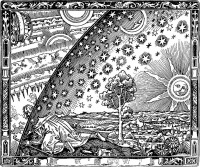Flammarion engraving
From The Art and Popular Culture Encyclopedia
| Revision as of 21:52, 11 November 2013 Jahsonic (Talk | contribs) ← Previous diff |
Current revision Jahsonic (Talk | contribs) |
||
| Line 1: | Line 1: | ||
| + | [[Image:Flammarion engraving.jpg|thumb|right|200px|''[[Flammarion engraving]]'', a wood engraving by an unknown artist, so named because its first documented appearance is in Camille Flammarion's 1888 book ''L'atmosphère: météorologie populaire'' ("The Atmosphere: Popular Meteorology").]] | ||
| {{Template}} | {{Template}} | ||
| - | The '''Flammarion engraving''' is a [[wood engraving]] by an unknown artist, so named because its first documented appearance is in [[Camille Flammarion]]'s 1888 book ''L'atmosphère: météorologie populaire'' ("The Atmosphere: Popular Meteorology"). The engraving has often, but erroneously, been referred to as a [[woodcut]]. It has been used to represent a supposedly medieval cosmology, including a [[flat earth]] bounded by a solid and opaque sky, or [[firmament]], and also as a metaphorical illustration of either the [[Science|scientific]] or the [[Mysticism|mystical]] quests for knowledge. | + | The '''Flammarion engraving'''[http://commons.wikimedia.org/wiki/File:Flammarion.jpg] is a [[wood engraving]] by an unknown artist, so named because its first documented appearance is in [[Camille Flammarion]]'s 1888 book ''L'atmosphère: météorologie populaire'' ("The Atmosphere: Popular Meteorology"). The engraving has often, but erroneously, been referred to as a [[woodcut]]. It has been used to represent a supposedly medieval cosmology, including a [[flat earth]] bounded by a solid and opaque sky, or [[firmament]], and also as a metaphorical illustration of either the [[Science|scientific]] or the [[Mysticism|mystical]] quests for knowledge. |
| + | ==Description== | ||
| + | The engraving depicts a man, depicts a man crawling under the edge of the sky, depicted as if it were a solid hemisphere, to look at the mysterious [[Empyrean|Empyrean]] beyond. He is clothed in a long robe and carrying a staff, who kneels down and passes his head, shoulders, and right arm through a gap between the [[Biblical names of stars|star]]-studded sky and the earth, discovering a marvellous realm of circling clouds, fires and suns beyond the heavens. One of the elements of the cosmic machinery bears a strong resemblance to traditional pictorial representations of the "[[Ophan|wheel in the middle of a wheel]]" described in the visions of the Hebrew [[prophet]] [[Ezekiel]]. One of the most significant features of the landscape is the tree, which some people have interpreted as the Kabbalistic Tree of Life. | ||
| + | |||
| + | The caption that accompanies the engraving in Flammarion's book reads: | ||
| + | |||
| + | :"A missionary of the Middle Ages tells that he had found the point where the sky and the Earth touch..." | ||
| ==See also== | ==See also== | ||
| *[[Biblical cosmology]] | *[[Biblical cosmology]] | ||
| Line 8: | Line 15: | ||
| *[[Primum Mobile]] | *[[Primum Mobile]] | ||
| *[[Empyrean]] | *[[Empyrean]] | ||
| - | |||
| - | |||
| {{GFDL}} | {{GFDL}} | ||
| + | [[Category:WAC]] | ||
Current revision
|
Related e |
|
Featured: |
The Flammarion engraving[1] is a wood engraving by an unknown artist, so named because its first documented appearance is in Camille Flammarion's 1888 book L'atmosphère: météorologie populaire ("The Atmosphere: Popular Meteorology"). The engraving has often, but erroneously, been referred to as a woodcut. It has been used to represent a supposedly medieval cosmology, including a flat earth bounded by a solid and opaque sky, or firmament, and also as a metaphorical illustration of either the scientific or the mystical quests for knowledge.
Description
The engraving depicts a man, depicts a man crawling under the edge of the sky, depicted as if it were a solid hemisphere, to look at the mysterious Empyrean beyond. He is clothed in a long robe and carrying a staff, who kneels down and passes his head, shoulders, and right arm through a gap between the star-studded sky and the earth, discovering a marvellous realm of circling clouds, fires and suns beyond the heavens. One of the elements of the cosmic machinery bears a strong resemblance to traditional pictorial representations of the "wheel in the middle of a wheel" described in the visions of the Hebrew prophet Ezekiel. One of the most significant features of the landscape is the tree, which some people have interpreted as the Kabbalistic Tree of Life.
The caption that accompanies the engraving in Flammarion's book reads:
- "A missionary of the Middle Ages tells that he had found the point where the sky and the Earth touch..."
See also


